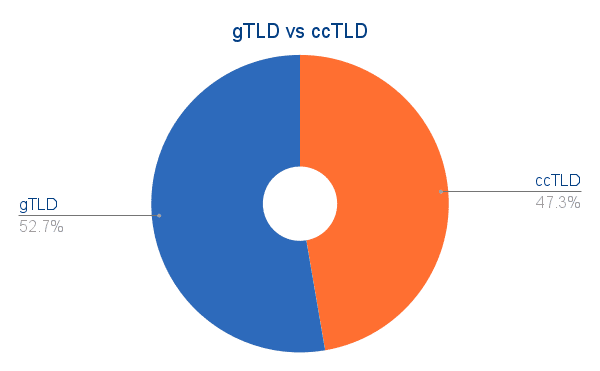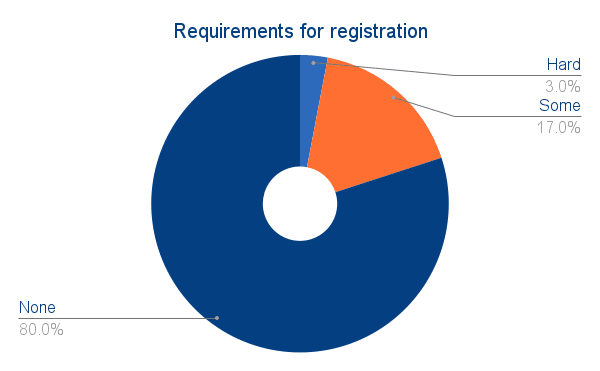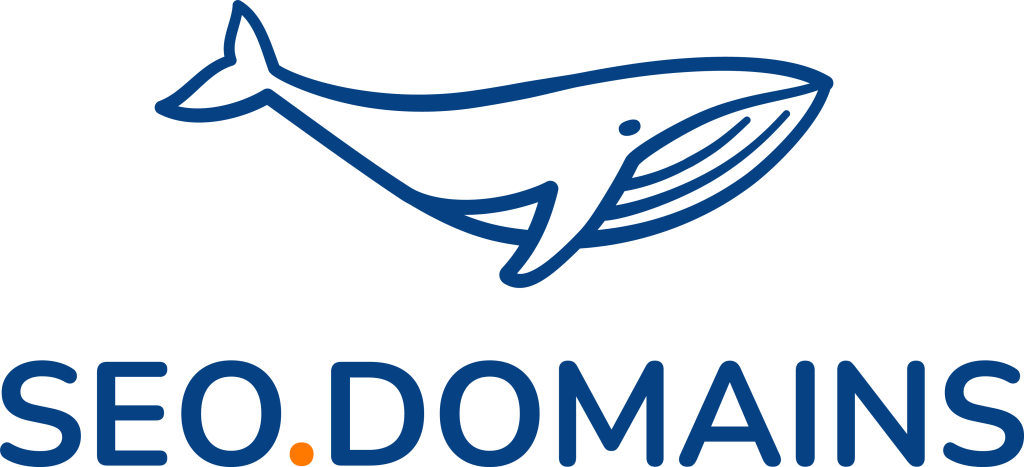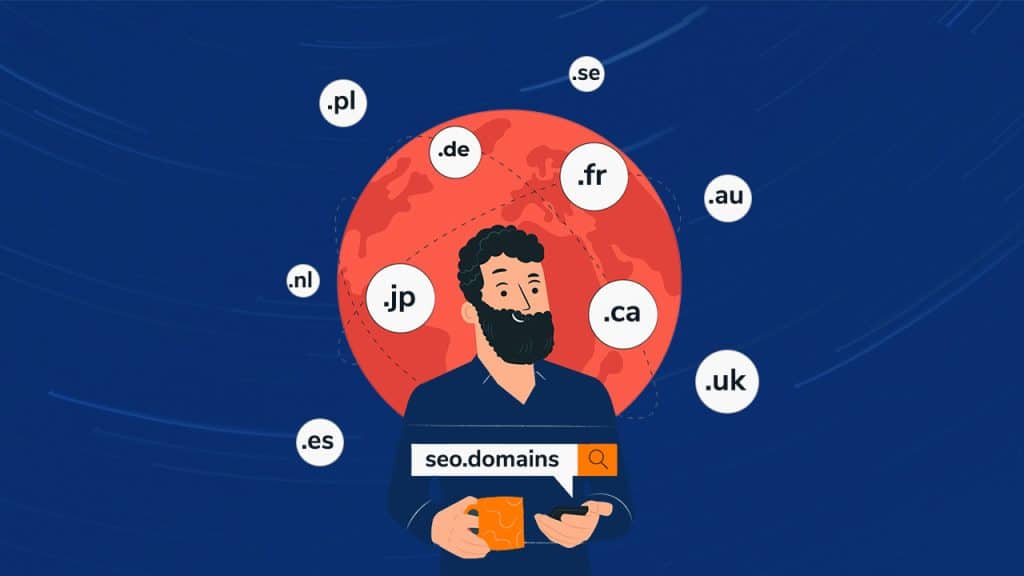You probably wonder why we offer so many expired ccTLD domains when most clients want .com domains with metrics such as DA 20+, Majestic Trust Flow 10+, Referring domains 15+.
Well, we could send you a list of 1000 expired .com domains to choose from, and guess what? The majority of them will be spammed. Even filtered from 200 million expired domains, the best 1000 would still suck. We cannot create what doesn’t exist. What good is a domain with high Trust Flow if it’s still spam?
Table of Contents
What Does ccTLD Mean?
CcTLD stands for Country Code Top-Level Domain. It shows both users and search engines in what country is a website registered. Besides a country, this extension can also stand for a sovereign state or a dependent territory where this site resides.
For example:
- https://www.domain.co.uk – United Kingdom
- https://www.domain.gr – Greece
- https://www.domain.ro – Rоmania
- https://www.domain.com.eu – European Union
Country code top-level domains normally use the ISO 3166-1 country codes. There are just a few exceptions to this rule, where ASCII identifiers are utilized – for example, .uk instead of .gb.
Pros of ccTLD Domains
The best PBN experts in the world, some of whom are customers of ours, are now buying country domains, with .gr being a favorite. It’s one of the many ccTLDs where expired domains have:
- Renewal fees as cheap as .com;
- Complete Whois privacy by default;
- Easy management;
- Original content in English for 40% of domains;
- The transfer is often free;
- No annoying transfer locks;
- Direct registry access in case of registrar trouble.
And to be fair, Google doesn’t really care about the history language of the domains.
In terms of international SEO, ccTLDs are the best way to show both search engines and users that this site and its content are targeted to a specific country, but not necessarily a certain language. When your site uses a ccTLD, Google presumes that your site and its content are relevant to the location targeted by the ccTLD and it should show on SERPs in this specific area.
Debunking the myths about ccTLDs
The total registered gTLDs (.com, .net, .org, etc.) are 167 million and ccTLDs are about 150 million which is also quite an impressive amount. As you can see gTLDs and ccTLDs have almost the same share of the pie of total registered domains, plus they also offer similar quality.

And gTLDs are much more used for PBNs than ccTLDs because of the reasons we’ll cover below. But it turns out that most of these reasons are actually myths. Some of them are partially true, but the rest are completely wrong, so we’re going to debunk them.
Myth 1: ccTLDs are more expensive
Truth: Get the bottom-low price directly from the registrar.
Explained:
This myth is caused mainly by bad registrars that overcharge for domain registration and renewal. If you learn the actual cost prices a.k.a the bottom-low price the registry sells a domain to a registrar without a loss, you’ll see that most ccTLDs (.uk, .de, .ru, etc) are in reality cheaper than .com.
When you know these prices, you can negotiate with the registrar to give you a good price. If you buy a small number of domains, you can get the cost price plus 1 or 2 euros on top. If you purchase a lot of domains, you can negotiate for the cost price plus some cents on top.
Myth 2: You have to be a local resident to own a ccTLD
Truth: 80% of ccTLDs have no requirements to register, 17% have some requirements that can be worked around, and 3% are indeed hard to register.
Explained:
People think that to own a .co.uk you have to be from the UK and to own a Swedish domain you have to be Swedish. There’s some historical truth behind this myth – this used to be the procedure in many countries. But nowadays most countries have the freedom to sell to anyone.
Following is the actual data from our database because we know how many domains are registered in each ccTLD. About 80% have no requirements, so it’s effortless to buy them. Only 17% have some requirements that you have to worry about.

For example, to own a .ca domain you have to be a Canadian citizen. For a .eu domain, you have to have an address in the European Union. That’s why a lot of UK domain holders of .eu lost their domains after Brexit.
In most other cases, citizenship is not a problem. Registrars want to sell more domains, so they offer various options to have different data, not yours, sent to the registry, and then you can still own these domains.
Some registrars provide a “Trustee service” which means they register the domain for you with their local information. This type of service is very useful for .eu domains. But have in mind that some countries, like Australia, forbid it.
And there is a very small percentage of ccTLDs, like 3%, that are really hard to register. They need a local company with the name of the domain, which makes it harder to use the Trustee service or they need some other specific information. But there is a trend of liberalization in this area, so fewer and fewer ccTLDs actually require anything.
Myth 3: ccTLDs are too hard to manage
Truth: While ccTLDs can be hard to manage, if you choose the right registrar, you’ll handle it.
Explained:
To be honest, this myth is partially true. Sometimes managing a lot of different extensions and different registrars can feel like a lot of hassle. But again, the problem exists if you have bad registrars and even worse if you have a reseller who buys from a bad registrar and you don’t even have contact with the bad registrar itself.
You can find yourself in frustrating situations such as the inability to renew or transfer a domain, trouble with changing basic information, or spending too much money on these tasks. So it’s only natural for people to feel unhappy if they’ve struggled like that.
The trick to easy management of ccTLDs is to choose small local registrars that provide high-quality service, have a dedicated support team, and really know their local market.
For example, if you buy domains from Greece just use Greek registrars. They will have know-how about the ecosystem and everything will work perfectly. You’ll have constant support because when they operate in a smaller market you are more important to them. You’re a valued customer.
Myth 4: ccTLDs only help you rank in the country where you bought them from
Truth: Multiple case studies prove the opposite.
Explained:
Of course, you shouldn’t go overboard and try to rank a US website on Google.com with 100% .uk domains. You know that would be stupid. But you can use them in the mix as part of your offsite SEO strategy. Just avoid directly conflicting countries like the US and UK, the German-speaking countries (Germany, Austria, Switzerland), or any countries speaking the same language because Google takes into consideration the links of the domain to determine where actually to rank it.
If you use expired domains where there’s no conflicting language you can use anything. For example, you can use Greek domains to rank on Google.com and it will work. Maybe it won’t have 100% of the effectiveness of .com domains that are used in the US but it will be twice as cheaper.
So overall, a much better option.
It’s natural for websites from small countries to link to authority websites. It’s natural to have backlinks between different countries. You can use anything in the mix, it’s not a problem that your domain is from some weird country.
Actually, domains from weird countries are the best because they have no local market so they’re easier to catch, they’re cheaper to buy and they have strange stuff in the Whois data. Google just won’t bother to deeply inspect their unique Whois, and will probably miss a potential fingerprint because it’s just too small of a country, with too few domains.
And also, if you strictly want to use only US domains for the US market, there are .co, .io and others that will work just as fine. For example, .io is a British Indian Ocean Territory, so you can use .io for your SEO strategy. It’s not an actual country and Google will not try to rank you in Google.io. Simply because Google.io doesn’t exist. So Google classifies this as a geo-neutral domain or US domain in the context of Google.com if it had US backlinks.
Why We Believe in the Power of ccTLD Domains
You can look around and pay for as many low-quality services for expired .com domains as you like, but the truth is – there is barely anything left out there. This is something we at SEO.Domains realized over 2 years ago. We have an almost complete database of all the expired domains in the world and we can literally see it.
If you put all expired .com and .gr in a single pool and take out the best 500 expired domains, you will have 500 .gr domains. And guess what? They will be gone in no time.
The same goes for .co.uk, .de, .nl, .be, .es, .it and everywhere else. There is nothing good left in .fr already. The expired domain industry sells all the domains that expired within the last 15 years at a great speed and not enough domains expire every day to fill the gap (of course all the high authority SEO domains are being caught at the drop).
So hurry up and get your share of quality ccTLD before somebody else beats you to the race.
To learn even more about ccTLDs, check out this video:



MORE FROM SEO.DOMAINS
Winter Promo: End the Year Strong, Start Q1 Stronger
Dec
How Reliable Hosting Supports Better SEO Performance
Dec
Why Choosing a Local Hosting Provider Can Boost Your SEO
Dec
⚡ Black Friday: 30% OFF or 100% Deposit Match?
Nov
Chiang Mai SEO Conference 2025: SEO.Domains Takes the Stage as a Gold Partner
Nov
SEO Estonia 2025: Actionable SEO, Pub Crawls, and the Comeback of the 301 redirects
Jul